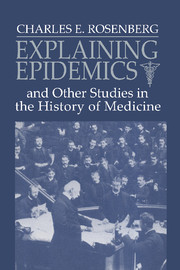Book contents
- Frontmatter
- Contents
- Acknowledgments
- Introduction: Why care about the history of medicine?
- I Ideas as actors
- II Institutions and medical care
- III The past in the present: Using medical history
- 11 The crisis in psychiatric legitimacy: Reflections on psychiatry, medicine, and public policy
- 12 Disease and social order in America: Perceptions and expectations
- 13 What is an epidemic? AIDS in historical perspective
- 14 Explaining epidemics
- 15 Framing disease: Illness, society, and history
- 16 Looking backward, thinking forward: The roots of hospital crisis
- Index
12 - Disease and social order in America: Perceptions and expectations
Published online by Cambridge University Press: 29 March 2010
- Frontmatter
- Contents
- Acknowledgments
- Introduction: Why care about the history of medicine?
- I Ideas as actors
- II Institutions and medical care
- III The past in the present: Using medical history
- 11 The crisis in psychiatric legitimacy: Reflections on psychiatry, medicine, and public policy
- 12 Disease and social order in America: Perceptions and expectations
- 13 What is an epidemic? AIDS in historical perspective
- 14 Explaining epidemics
- 15 Framing disease: Illness, society, and history
- 16 Looking backward, thinking forward: The roots of hospital crisis
- Index
Summary
Written for a conference on AIDS in the mid-1980s, this essay was intended to place a contemporary crisis in historical context. Although AIDS provided an occasion, the argument reflected a longstanding prior concern. This was my effort to understand differences among the old left of the 1930s, 1940s, and 1950s, the no-longer-so-new left of the late 1960s and 1970s, and the less self-assured critical spirit of the 1980s. The older generation shared a faith in the ultimate and unambiguous benefits of science and technology in a just society; their children accepted a parallel yet opposed certainty. They regarded the presumptive benefits of scientific progress as necessarily illusory and imprisoning – and many of its fundamental conceptions as no more than arbitrary social constructions.
The history of AIDS demonstrates the inadequacy of either species of certainty. There were no one-dimensional answers. AIDS could hardly be dismissed as an exercise in stigmatizing the deviant; it obviously had a strong biological component. It was not simply a construction even if it had been constructed. Yet at the same time nothing marked the epidemic more starkly than its ability to evoke and reproduce preexisting social values and attitudes. The diversity and complexity of reactions to AIDS has underlined the need to look carefully at the elusive process through which society constructs its reponse to disease. And we know that there will be no simple and formulaic answers; in the 1990s they are neither intellectually available nor politically compelling.
- Type
- Chapter
- Information
- Explaining Epidemics , pp. 258 - 277Publisher: Cambridge University PressPrint publication year: 1992
- 1
- Cited by



